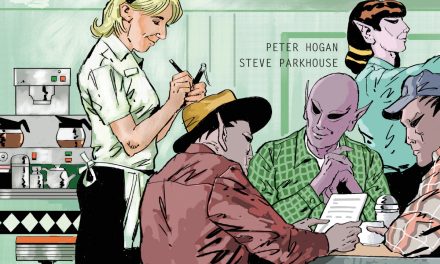
Theros: Beyond Death is finally here! The PreRelease is the most exciting time in Magic. You get to explore the frontiers of a new set, be the first one to pull off that combo that everyone is talking about, and crush your friends and get some packs. It can also be daunting to play with new cards for the first time. The most important thing to know going into a PreRelease is the themes and mechanics of the set.
Once you know what the mechanics are you can figure out what is going on in a limited environment. The second most important thing is to know what the color pairs are about. Your sealed deck will almost always be two colors and knowing what sort of strategies are supported can help you build your perfect deck from your pool. So let’s dive into the mechanics of Theros: Beyond Death.
Constellation
Theros is a traditionally a land of enchantments and this set is no exception. The returning constellation mechanic rewards you whenever you play an enchantment. The effect that it gets you varies widely, the only thing tying these cards together is they trigger when an enchantment enters the battlefield. This means that if you have a powerful constellation trigger, such as Eutropia or Setessan Champion, you might consider playing some mopey enchantments to fill out your deck.

The rares and multicolored cards are the exception. For the most part, enchantments are plentiful and constellation triggers at common are mostly just and upside and not a gameplan. A lot of your creatures will be enchantments, a lot of the removal spells are also auras, and a lot of the sagas will probably make your deck if they are in the right colors as well.
This also works the other way. If you open some ways to kill enchantments those might be able to counter your opponents removal or kill their creatures and you should main deck them. Think of constellation cards as a little bonus, and don’t try to play bad enchantments to trigger them. You should be able to do that only playing powerful cards.
Devotion
Theros is a land of fickle gods who will only provide their blessing if you have some conviction. Devotion just means the “amount of colored mana symbols among permanents you control”. For example, if you control a Setessan Skirmisher and cast Setessan Petitioner, you’ll get 3 life. One from the Skirmisher and two from the Petitioner itself. Devotion rewards you for getting a lot of crap into play.

So if you’re gearing up to cast a devotion card make sure you don’t sacrifice or trade off your permanents in combat so you get the most out of your card. From the other perspective, if you notice that your opponent refuses to block or attack if their stuff might die, they probably have something that cares about devotion.
More On Devotion In Theros: Beyond Death
When you’re building your sealed deck look out for the strong payoffs. If you have one lean more heavily into that color. If you open an Erebos, try to build a mostly black deck and then patch up any holes with a support color. There are not a lot of cards that really pay you off for being devoted at common, but there are demi-gods and Gray Merchant at uncommon and Gods at mythic rare so keep your eyes out for those.

The most complicated thing about devotion is the difference between abilities that check on resolution and mana abilities. If you kill a Setessan Petitioner with its trigger on the stack, the trigger will resolve after the Petitioner is dead, and you won’t count it’s green mana symbols toward it’s trigger. On the other hand, if you cast a Daybreak Chimera and your opponent does something to mess with your devotion in response, it’s too late and your Chimera will still resolve. Keep in mind what kind of devotion cards your opponent has and if you should try to take your opponent off devotion preemptively or in response.
Escape
I’m not an MTG lore expert, but even I can tell there’s something going on with the Therosian underworld right now. There are some serious leaks going on. Escape cards can be cast from the graveyard by paying an amount of mana and exiling an amount of cards from your graveyard. Escape is very powerful, you just straight up get your cards back at very little cost. The downside of escape is that it has diminishing returns. Its very hard to build an escape deck, because they are all competing for the same resource, cards in your graveyard.

Instead you should figure out which of your escape cards is the best for your deck and focus on those. Another drawback of escape is that it does not play well with the previous two mechanics. Escape wants you two do lots of trading with your creatures and cast lots of instants and sorceries that go to the graveyard right away. Constellation wants you to play a lot of a specific card type that is a permanent and not an instant or sorcery. Devotion wants you to build up some followers and keep them in play, IE not in your graveyard. Even though escape is strong, there’s a lot of tension with how you enable it, while also enabling the other mechanics.
That’s it for the core mechanics of the set, now let’s get into the color pairs and what they do.
Blue/White Aura/Tempo

Blue/White can get a lot of mileage out of its fliers, especially when you combine them with spells like Stern Dismissal. Normally Stern Dismissal only delays your opponent, but if you’re attacking them in the air; every turn you buy is more damage. The fliers are also nice targets for some of the more powerful auras in the set, such as Commanding Presence.

Blue/Black Escape/Mill

Blue/Black is the color combination with the most escape enablers. Use cards like Funeral Rites and Towering-Wave Mystic to get lots of fodder for your escape cards. This deck is more instant/sorcery based than most of the other decks in the set.

Black/Red Sacrifice

Black/Red has this sub-theme in lots of limited formats. Temporary steal your creature effects plus sacrifice outlets is a combo every seasoned drafter knows. The actual Act of Treason effect in Theros: Beyond Death, Portent of Betrayal, is not that good. Paying an extra mana to scry one is not a good deal.

Instead, you can use escape cards to provide recurring food for your sac outlets. Satyr’s Cunning is a cheap source of fodder. Pay attention to what exactly you’re allowed to sacrifice. Some cards will also let you sac an enchantment to pay its cost and there are also lots of auras whose main value is their “enter the battlefield” trigger. Aspect of Lamprey is a good thing to sacrifice to your Final Flare.

Red/Green Beef

Red/Green wants you to have a creature with power 4 or greater. This is actually really easy to do, especially with all these auras running around. Illysian Caryatid is the best payoff for this effect, because if you’re trying to cast big creatures you’d want the extra mana anyway. Don’t worry about this too much. Just play big stuff and if your creature gets a small bonus then great.
Green/White Auras

Green/White has a lot of decent constellation triggers at higher rarities and it has plenty of auras to support that. Make sure you have plenty of creatures so that you have someone to wear your enchantments. Heliod’s Pilgrim really shines here. Pay extra attention to Dreadful Apathy and Warbriar Blessing because those two cards let you get to a high enchantment count, but still have interaction.

Black/White Graveyard/Auras

Black/White doesn’t have a very strong theme in Theros: Beyond Death, but you can get some extra value out of its gold uncommon, Rise to Glory. It specifically points out auras, not enchantments. So you need Mire’s Grasp and Dreadful Apathy because those are two auras that you can get into your yard with minimal effort. It’s also worth noting that these two colors have the best devotion cards at uncommon and common, Gray Merchant and Daybreak Chimera.
Black/Green Escape

Black/Green, like Blue/Green, is also a color combination with a lot of escape enablers. You can use Relentless Pursuit to fill up your yard with plenty of fuel for the escapees. Voracious Typhoon is a big difference between the Green and Blue versions of the escape deck. When you are recasting a 7/7 the game will be over pretty quickly.
Blue/Green Constellation

Blue/Green is the color combination with the most constellation triggers. You’ll want to play some of the more medium enchantment creatures in order to get your deck humming. The real standout enchantment creature is Witness of Tomorrows, which has great stats and abilities for a common. It does cost 5 so you can’t play as many as you want, but its one of the best enablers for constellation cards.
Blue/Red Flash

Blue/Red has a theme that we saw a little bit of in Magic 2020, but is a lot deeper here in Theros: Beyond Death. Red/Blue has lots of cards that care about you casting a spell during your opponent’s turn. Try your best to combine your flash cards and instants like Vexing Gull with payoff cards like Arena Trickster.
Red/White Heroic

Heroic was not one of the returning mechanics from the old Theros Block. Well except on three or four cards that care about when you target them. They all have the same triggered ability: when you target this, give your team +1/+0. The lack of toughness boost means you want to go really wide when you play Red/White. Iroas’ Blessing is the best way to target your own creature, since it’s mostly a burn spell. A different blessing, Karametra’s, is important as a way to protect your hero’s. If you’re playing against this deck be careful to kill their creature in response to their enchantment, so they don’t get the indestructible bonus from the Blessing.
Remember, To Have Fun at Theros: Beyond Death PreRelease

That’s it for the color pairs and new mechanics. The most important thing to remember is that PreReleases are times to have fun, and hang out with other Magic players. Sure, you can win packs, but it’s all about the player experience. Have fun this weekend!
For more on Theros: Beyond Death, Magic: the Gathering, or any other general pop culture, check back to That Hashtag Show and follow THS Magic on Facebook.
All card images are courtesy of Wizards of the Coast.






